Nissan has unveiled the Z Proto, signalling the company’s intent to launch a new generation of the Z sports car. Shown at an event streamed from the Nissan Pavilion in Yokohama, Japan, the prototype features new design inside and out, as well as an upgraded powertrain with a manual transmission.
In Franklin, just south of Nashville, hundreds of Z owners and enthusiasts watched the Z Proto’s Yokohama debut on big screens from their vehicles in a socially distanced event– part of a weeklong schedule of activities during the 33rd annual International Z Convention (ZCON).
“The Z represents the joy of driving in its purest form and has helped shape Nissan’s DNA as a passionate, innovative challenger,” said Nissan CEO Makoto Uchida. “Ever since the first generation, it has captured the hearts of car enthusiasts all over the world. That’s why we’re so excited today to be able to say to them: Yes, the next one is coming!”
“The United States is home to one of the most devoted and enthusiastic Z communities in the world, with nearly 1.35 million total sales over the model’s 50-year history,” said Mike Colleran, senior vice president, Nissan U.S. Marketing and Sales. “With new models like Sentra and Rogue opening new eyes to our brand, Z Proto is our loudest statement yet that Nissan will continue to bring vehicles that thrill to U.S. showrooms.”
Sporting a bright yellow pearlescent paint – a tribute to a popular paint scheme on both the first-generation 240Z and the 300ZX – the Z Proto boasts a fresh exterior design with a silhouette that calls back to the original model.
Using a theme that combines elements of previous generations while also projecting futurism was challenging, said Alfonso Albaisa, head of design at Nissan.
“Our designers made countless studies and sketches as we researched each generation and what made them a success,” Albaisa said. “Ultimately, we decided the Z Proto should travel between the decades, including the future.”
The shape of the hood and the canted, teardrop-shaped LED headlights are both reminders of the original Z. The rectangular grille dimensions are similar to the current model, although the grille fins nod to the past.
“The LED headlights have two half-circles that hark back to the Japan market-only 240ZG of the 70s,” Albaisa explained. “The ZG has clear dome lenses over the headlight buckets, which under light give off two circular reflections over each headlight. We liked that unique characteristic and discovered that it naturally fit with the Z’s identity.”
The link to the original Z is most striking when viewing the Z Proto from the side, Nissan says. The roofline flows from the nose to the squared-off rear to create a distinctive first-generation Z profile whose rear edge was slightly lower than the front fender height giving the Z its unique posture. The signature transition from the rear quarter glass to the low-slung position of the rear tail adds to the effect.
The rear takes inspiration from the 300ZX taillights and are set within a rectangular black section that runs across the rear and wraps around the outer edges.
The car also features lightweight carbon fiber treatments on the side skirts, front lower lip and rear valance, 19-inch alloy wheels and dual exhausts.
The interior design team sought advice from professional motorsports legends to give the Z Proto an ideal sports car cabin, both for road and track, Nissan says. All vital information is found in the 12.3-inch digital meter display and arranged to help the driver grasp it at a glance, such as the redline shift point at the twelve o-clock position.
The new, deep dish steering wheel offers the driver quick access controls without losing its vintage aesthetic.
Yellow accents are found throughout the cabin, including stitching on the instrument panel. The seats feature special accent piping and layered seat material to create depth.
Under the elongated hood is an enhanced V6 twin-turbocharged engine mated to a six-speed manual gearbox.
